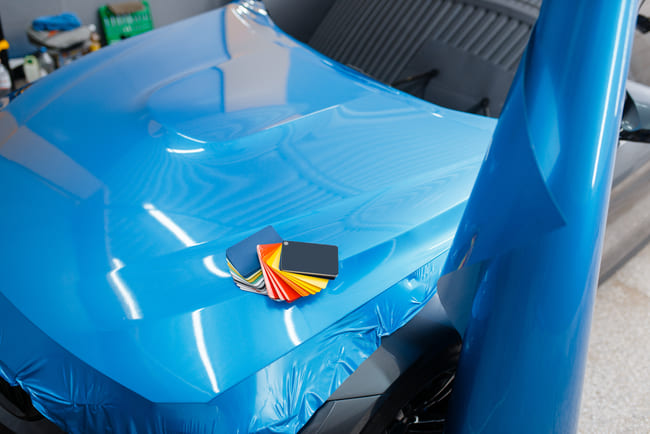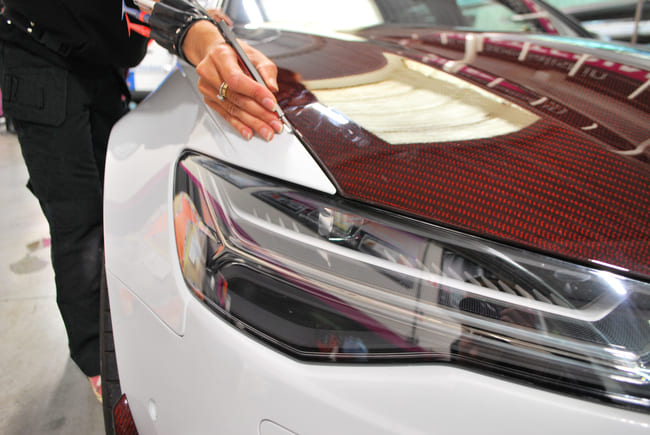
If you want to give your vehicle a new look and love to dress up the exterior of your car, then there are numerous ways to present the exterior and interior of your vehicle in the best possible light. Some prefer to give the vehicle new upholstery. Still others hope that new rims will put the vehicle in a whole new light. In addition, rear spoilers can be attached and brake calipers painted so that the vehicle radiates more sportiness. No matter which option you choose, the vehicle owners love the new look of the vehicle. But what is the possibility to completely turn the exterior of a car upside down, so that a car is hardly recognizable? A completely new color of the entire body is best suited for this. The vehicle owner has two options here. Either the car can be painted or foiled. Both options have advantages and disadvantages. In the following we want to specifically go into the process of foiling. We describe the advantages and disadvantages, discuss the costs involved and also explain what is and isn't allowed.
Contents
What are the advantages and disadvantages?
At the very beginning you should find out about the advantages and disadvantages of foiling, so that you can see right from the start whether you are choosing the right variant. But first: what exactly is foiling? This is a self-adhesive film that is pulled over the surface of the body and sticks there. However, you should know here that this process should be carried out almost exclusively by professionals. This is a complex and precise job that you should only do yourself if you have a lot of experience and a steady hand. In addition, special equipment and specialist tools are required. But now to the advantages of foiling. So why should you choose it? A typical advantage at this point is that foiling is significantly cheaper than painting. In addition, the process is significantly less time-consuming. In addition, this process – in contrast to the paintwork – can be solved very easily. In addition, of course, it offers good protection for the original paintwork. In addition, numerous different designs or colors can be selected.

Certain window foils can also offer special protection against breakage, as well as against UV radiation and strong heat for the windows of a vehicle. Up to this point everything speaks for a car wrap. But are there also possible disadvantages that could arise?
There aren't many of these, but you should still be aware that durability is limited at this point. While paint lasts a long time on a car, film doesn't have a particularly long lifespan. In some places, the foil can peel off, so that cracks can also form. In addition, the surface can become dull and the colors can also become paler and paler over time. The film is therefore removed every two to ten years and renewed if necessary. If the vehicle has been partially wrapped, a large difference in the body parts can be seen after peeling off. Because where the film protected the paint, it was of course not exposed to the weather and is in good condition. While the other body panels look less good. Thus, a clear difference can be seen between the foiled and non-foiled areas.
What costs should I expect?
There are big differences in prices. First of all, it is crucial how much area should be foiled. Would you like to fully wrap your vehicle or is partial wrapping sufficient? In addition, of course, the quality of the product is important and also the design that you want. If a specialist workshop uses a product of the highest quality, the final price that you will pay is of course significantly higher. As far as design is concerned, certain samples are of course more expensive. Ultimately, however, the condition of your vehicle is also very important at this point. If this is good, the specialists can start their work directly. However, if the condition is rather poor, preparation work must be carried out before the work can begin. This shows that the price range varies greatly here. However, if the entire vehicle is to be wrapped, you can expect costs of between EUR 2,000 and EUR 5,000.
Can I wrap the vehicle myself?

It is best not to do this unless you have the experience, a steady hand, good skill and the right equipment. Of course you save the wages if you trust yourself to do this job. But remember that even the smallest mistake can result in blistering, overlapping and wrong cuts. You may have saved a lot of money in the end, but if you end up driving a vehicle that has visual defects on the surface, then it certainly wasn't worth the saving.
What is allowed and what is not?
You should definitely take into account that not everything is allowed when it comes to foiling. For example, some parts of the vehicle must remain clear and must not have film, such as the headlights, as well as the number plate and other lights. Of course, the windows of a car may at most be tinted, and the driver must always remain visible. Films that could dazzle other road users or even distract them from the traffic are of course not permitted. Signal or warning colors as well as colors that reflect too strongly must also be avoided at this point. There are also words or coats of arms that are protected and are therefore not allowed to be seen on the body. An example would be the inscription “Police” that was wrapped on the body of a car.
The Conclusion and a tip from CarTipsandmore
On the whole, wrapping a vehicle speaks for itself: it looks very good, can be easily stuck over the original paint and protects the body from the weather . However, the film should be removed again after a few years, otherwise it will begin to peel off at the corners of the body parts. CarTipsandmore recommends entrusting this tedious work to specialists, as the smallest mistake can significantly affect the appearance of the foil. It is better not to save at this point and turn to professionals so that the work is carried out in the best possible way.
